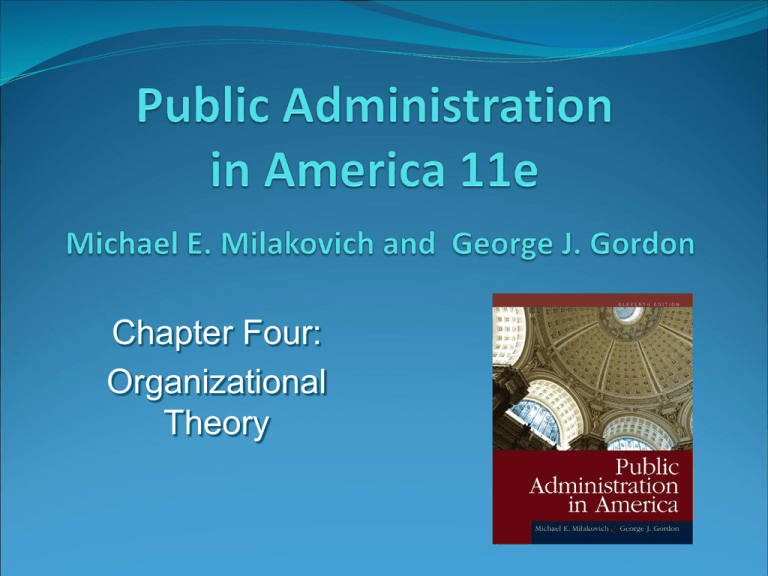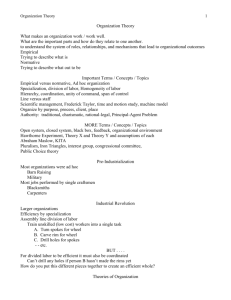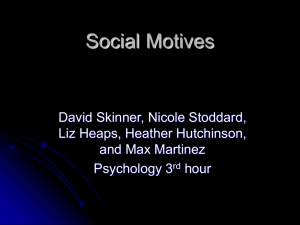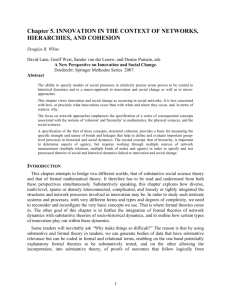Formal Theories of Organization - WEB Du Bois at WEBDuBois.org
advertisement

Chapter Four: Organizational Theory As a citizen interested in government and as a former legislator, I had long believed that too many governmental programs are botched because they are started in haste without adequate planning or establishment of goals. Too often they never really attack the targeted problems. Jimmy Carter 2002 Nobel Peace Prize recipient, then governor of Georgia, National Governors Conference, June 1974 Formal Theories of Organization Weber’s Bureaucratic Model Division of labor/functional specialization Hierarchy Formal framework of rules and procedures Maintenance of files Professionalization Formal Theories of Organization Weber’s model based on legal and political authority Reaction to patronage system Control Broad framework Focus on uniformity (not diversity) Formal Theories of Organization Contemporary American public administration differs from Weber Responsive to those outside hierarchy Functional overlap Merit system plus other personnel systems Bureaucratic professionals Only recent career emphasis Formal Theories of Organization Taylor’s Scientific Management Managerial focus Adapts production practices and values Efficiency Rationality Productivity Profit “One best way” Formal Theories of Organization Scientific Management tools Time-and-motion studies Standardization Task-related capabilities Formal Theories of Organization Scientific Management shortcomings Workers just “cogs in the machine” Profit only motivation Does not account for supply and demand But significant impact on private industry and public administration Formal Theories of Organization Impact of Taylor White’s Introduction to the Study of Public Administration Principles of administration approach The Human Relations School Human relations approach: worker’s noneconomic needs and motivations Hawthorne studies (1927-1932) Hawthorne/halo effect Importance of noneconomic incentives The Human Relations School Barnard’s zone of acceptance Lewin’s leadership styles Authoritarian Laissez-faire Democratic Emphasizes role of leadership in productivity The Human Relations School Human relations shortcomings Does not account for worker/manager conflict Discounts effects of formal structure Ignores role of technology What is worker’s relationship to work itself? Organizational Humanism New assumptions about workers: Work intrinsically motivates Work satisfies many needs Work is a central life interest Workers can be self-motivating Theory X and Theory Y Summary Source: Reproduced by permission of the publisher, F. E. Peacock Publishers, Inc., Itasca, Ill. From Robert T. Golembiewski and Michael Cohen, eds., People in Public Service: A Reader in Public Personnel Administration, 1970 copyright, p. 380. Maslow’s Hierarchy of Needs Source: Abraham Maslow, Motivation and Personality, 2nd ed., Harper & Row, 1970, accessed http://www.union. umd.edu/GH/basic needs/index.html. Organizational Humanism Organizational humanism criticisms: Workers have widely varying needs Does everyone self-actualize? Money primary motivation for many Type of work affects motivation/satisfaction Modern Organization Theory Separates facts from values Uses new empirical research methods Interdisciplinary Broader generalizations Modern Organization Theory Systems theory approach Inputs (and responses) Outputs Feedback Further inputs Simplified Model of a Political System Source: From David Easton, A Framework for Political Analysis. Copyright © 1979, 1965 by David Easton, reprinted with permission of the University of Chicago Press. Modern Organization Theory Closed systems Few internal variables/relationships Little vulnerability to external environments Open systems Highly complex, interdependent Expectation of change and uncertainty Seeks homeostasis Modern Organization Theory Information theory: organizations require information to prevent chaos Game theory: competition Theory Z: greater communication, feedback and worker involvement Values/Characteristics of Theory Z Source: Adapted from Clyde McKee, “An Analysis of ‘Theory Z’: How It Is Used in Japan’s Public Sector,” paper delivered at the 1983 annual meeting of the American Political Science Association, Chicago, September 1983. Reprinted by permission of Clyde McKee, Trinity College, Hartford, Conn. Modern Organization Theory Total Quality Management Empowered employees more committed to organizational goals Statistical process control techniques Appropriate for public sector? Learning organizations Organizational Dynamics and Behavior Process issues Communication Coordination Design issues Line and staff activities Centralization vs. decentralization Tall vs. flat hierarchies Alternative forms of organization Organizational Dynamics and Behavior Formal communications (official, directed, proper channels) Informal communications (many sources, many audiences, broader) Lateral or cross-functional communication (relatively formal, but cuts across hierarchy) Organizational Dynamics and Behavior Feedback can be formal or informal Good news travels easily Bad news often suppressed or rewritten Upward communication becoming increasingly important to organizations Organizational Dynamics and Behavior Dimensions of communication Purpose Obstacles Consequences Organizational Dynamics and Behavior Bargaining or conflict model Consensual or consensus-building model Communication style influences content, purpose, effectiveness and consequences of message Organizational Dynamics and Behavior Coordination Channels and mechanisms must be carefully established and maintained Designed to reduce difficulties Rarely neutral Obstacles include differing goals, preferences, uneven fiscal resources, political pressures, poor organization or leadership, communication breakdowns Organizational Dynamics and Behavior Improving coordination Role of leadership Central coordination Mutual adjustment More difficult to achieve in complex organizations Organizational Dynamics and Behavior Line functions vs. Staff functions Interaction important in public administration Some conflicts inevitable Traditional distinctions becoming blurred Centralization and Decentralization Centralization is traditional approach Control, internal program consistency Orderly operations Lack of flexibility and adaptability Decentralization becoming more acceptable Adaptive and responsive Increases meaningful participation Decreases accountability Flattening Organizational Hierarchies Tall Hierarchy Diversity of tasks Narrow span of control (efficient) Higher level employees seen as more professional Growing complexity of tasks Flat Hierarchy Top management is collegial; lower levels seen as equal Work groups may not have designated leader Decision-making shared Tall and Flat Hierarchies Alternative Forms of Organization End to hierarchy and competition Bennis’ participative management Reverse pyramid Organization Theory and Behavior in Perspective Organizations continually changing Most not fully closed or open Increasing interdependence Shift from formal hierarchy to more worker participation/team direction New values = new challenges









